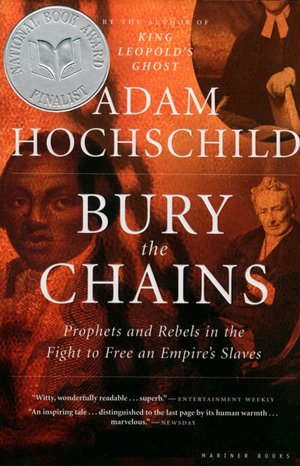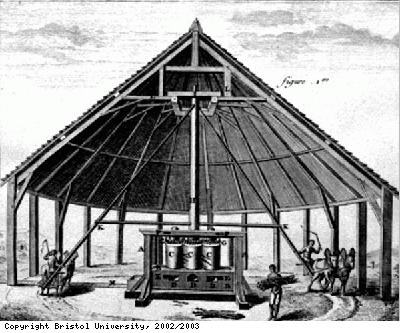
Bury the Chains: Prophets and Rebels in the Fight to Free an Empire's Slaves, by Adam Hochschild
From the UK Guardian, "Abolishing evil: Adam Hochschild gives the heroes - and one heroine - of the anti-slavery movement their due in Bury the Chains, says Robin White," by Robin White on 11 February 2005 -- Adam Hochschild's acclaimed account of the Belgian Congo, King Leopold's Ghost, told the tale of one of most terrible abuses of human rights: the theft of a vast country and the killing of between five and eight million of its inhabitants. Now, in Bury the Chains, he brings us the story of the most successful episodes of human rights activism, relating how, in just a few years at the end of the 18th century, a small group of men (and one woman) took on the vested interests of state, church and big business - and won.

Two hundred years ago, three-quarters of the world's population were in bondage of one kind or another. Eighty thousand slaves were trafficked every year from Africa to the New World. Ship owners, slave traders, sugar exporters, chocolate makers and plantation owners were earning fortunes. Only one MP, William Wilberforce, was active in the abolitionists' cause. Yet with organisation, enthusiasm and imaginative campaigning, the abolitionists eventually forced parliament to hear the cries of the suffering slaves and bend to the will of the British people. "It was the first time in history," writes Hochschild, "that a large number of people became outraged, and stayed outraged for many years over someone else's rights."
The problem facing the abolitionists can be summed up in one word: sugar. Sugar was like today's oil. Our British ancestors, unaware of its dangers to health, consumed huge quantities of the stuff and the economy would have ground to a halt without it. At the height of the slave trade, for instance, British imports from the tiny, sugar-producing West Indian island of Grenada, were eight times those from Canada.

The life of the slaves who cut and harvested the sugar was hellish and short: they died being captured, they died crossing the Atlantic, they died from beatings and they died from sheer hard work on the sugar plantations. During the period of the slave trade, more than two million were shipped to the Caribbean. At its close, there were fewer than 670,000. By contrast, the 400,000 shipped to the Americas (where sugar cane was not the only crop) had grown to four million.
Cutting sugar was back-breaking and dangerous. Slaves would often fall asleep and let their hands slip into the crushing mills. A machete was kept nearby to cut off an entire arm in order to save them. In contrast, the life of the plantation owners who exploited the slaves was sweet and extravagant. Here are the observations of the planters' eating and drinking habits from the diary of Lady Nugent, wife of the governor of Jamaica: "Such eating and drinking I have never seen before - a dish of tea, another of coffee, a bumper of claret, then Madeira; hot and cold meat, stews and fries and cold fish pickled, peppers, ginger, sweetmeats, acid fruits and sweet jellies." And that was just for breakfast.

Bury the Chains tells of the struggle to end slavery through the eyes of the few who plotted its downfall. Among them was John Newton, who worked on slave ships between West Africa and the Caribbean, where profits on a slave could be as much as 147%. He was a ruthless businessman and a dispassionate observer of the Africans he bought and sold: "I was brought a woman to buy, but being long breasted and ill made, I refused her."
Slave revolts on board ship were frequent and every captain had to be on the lookout. Newton mounted guns on deck and trained muskets on the captives' quarters to intimidate them. But still there were uprisings and Newton regularly had to lash them and "put them slightly in the thumbscrews" to keep them quiet. Newton turned to God, wrote the hymn "Amazing Grace" and, late in life, joined the anti-slavery cause.

Granville Sharpr rescuing Jonathan Strong
There was Granville Sharp, a royal musician who rescued a slave, Jonathan Strong, who had been brought to London by his master and so badly beaten up that he nearly died. Sharp went to court and had the slave freed. There was James Steven, a philanderer whose law studies had been financed by an uncle who bought sick slaves, cheaply, and oiled and fattened them up for resale. There was Olaudah Equiano, an eloquent, freed Igbo slave, who gatecrashed London society and wrote bestselling books about his own experiences.
But above all there was the abolitionist's most tireless worker, Thomas Clarkson. He was a giant of a man, more than 6ft tall, with striking red hair. Clarkson sprang into prominence when he entered, and won, England's top Latin essay competition. His chosen subject was the slave trade and his tract became famous. For the rest of his life he rode and walked the length of Britain (and quite a lot of France, too) addressing meetings, writing pamphlets, collecting signatures on petitions, and compiling a wealth of evidence on the horrors of the slave trade.

Thomas Clarkson
With the help of the Quakers (the only religious group to campaign wholeheartedly against the trade) Clarkson founded the all-white anti-slavery committee in 1787 at 18 Old Jewry, in the heart of the City of London. Initially they had spectacular successes. Slavery became the cause of the day. Newspapers took it up. It was the most discussed subject in London's popular debating societies. Just about every town and city in the country organised petitions on scrolls. One hundred and three were sent to parliament with 60,000 signatures. One scroll stretched the entire length of the debating chamber.
But when it came to votes in parliament, even the tiny but eloquent Wilberforce couldn't win the day. The 18th century may have been the age of enlightenment but there was a limited franchise and MPs did not need to respond to the wishes of the masses. Those who benefited from the slave trade fought back, employing lobby groups, bribing politicians and journalists. Wilberforce lost the debate by 163 votes to 88. It was a humbling experience, because it was not even a vote to abolish slavery as a whole, just the trade in slaves. (The argument was that if the human traffic could be stopped, then slavery itself would eventually wither and die.)

Clarkson and his friends were not discouraged. There was a nationwide sugar boycott - sugar sales dropped by a third. William Pitt, the prime minister, was enlisted on their side, and he spoke on the abolitionists' behalf in the second parliamentary debate a year later. But vested interests and those who argued that if Britain banned the trade then France would cash in again triumphed.
Then followed the wilderness years. British minds turned to other matters: the madness of George III, revolution in France, the war against Napoleon. The conditions of slaves got worse rather than better - it is estimated that more than two million whiplashes were administered each year.

It was to take another two decades before slavery's coffin was finally nailed. By that time electoral reform was in the air, and women's voices were beginning to be heard. The loudest was that of Elizabeth Heyrick, a former teacher and convert to the Quakers. In 1824 she published a pamphlet entitled "Immediate Not Gradual Abolition". Not for her the banning of the slave trade - she wanted all slavery ended for ever. Meanwhile, British soldiers, sent to the Caribbean to suppress slave revolts, returned home with a true picture of the evils of slavery. Their voices added to the clamour. The tide was finally turned and the emancipation bill was passed in 1833. But the victory was a tarnished one: as part of the deal, parliament agreed to pay £20m in compensation, not to slaves but to the slave owners.

Hochschild concludes with a debate on who did most to end the sordid trade in human beings. Was it Wilberforce or Clarkson? He is in no doubt that it was Clarkson, the ginger-haired giant. He is scathing of the attempts by Wilberforce's family to write Clarkson out of history, and this major piece of research is an attempt to put the record straight. Clarkson lived to the grand age of 86, still writing, still campaigning for the downtrodden. His last pamphlet was about the appalling conditions of British seamen.
This is a wonderful book, full of richness and colour - a celebration of many people's achievements. It's a testimony to both evil and goodness: a story in which, for once, goodness wins. [source: UK Guardian, Robin White is former editor of the BBC World Service programmes for Africa]
Adam Hochschild :: Bury the Chains from The Justice Conference on Vimeo.

Just finished the Portuguese translation. One of my bibles. I'm a longtime activist, had heard about the anti-slavery movement in England, had started Hochschild's King Leopold book (in English, and have it again to finish), but now have found another piece of heaven to add to great novels like Xogun and activist works like Jared Diamond's Collapse. I'll even compare it to watching one of Michael Moore's movies. The sense of intelligent compassion and revelation was profound. Simply lovely, stirring, and for such as me, incendiary.
ReplyDeleteWanted to add that Bart Jones' book on Hugo Chavez also was a gripping read and revelation, like Hochschild's masterpiece!!
ReplyDelete